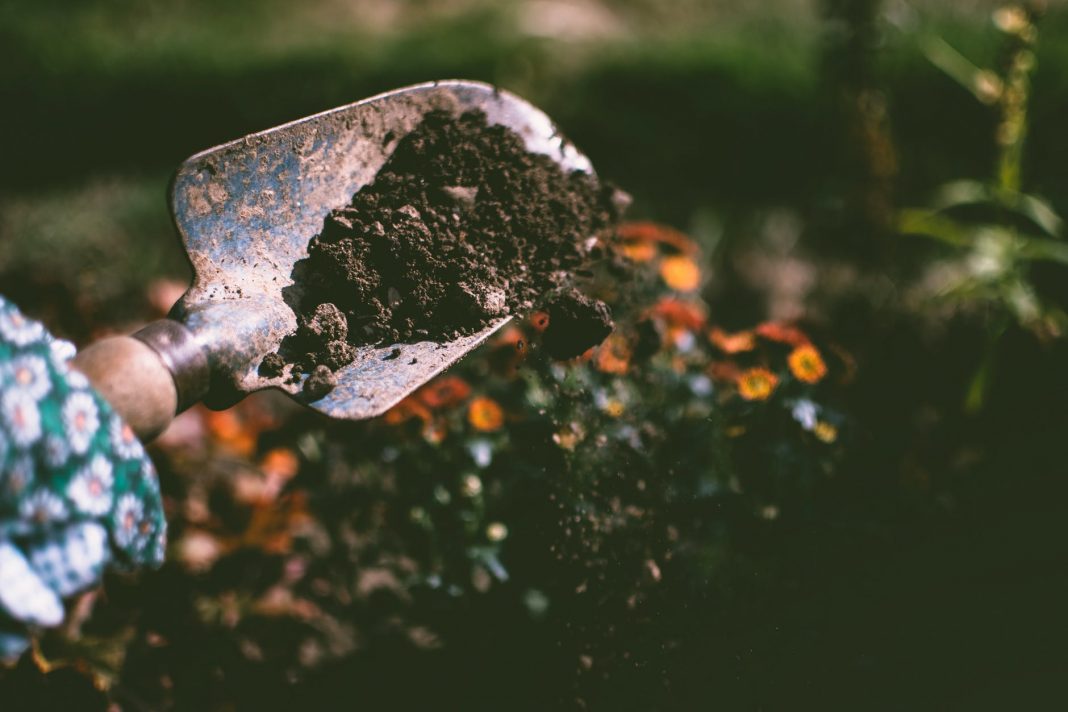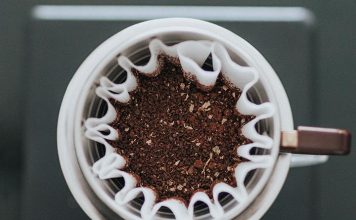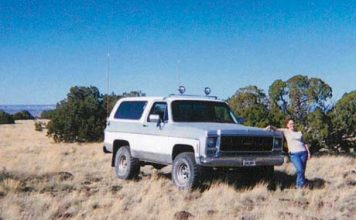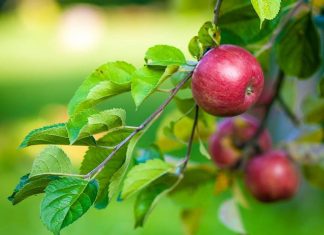 |
|
| Issue #99 • May/June, 2006 |
Gardeners are an ingenious lot. Trial and error, time, study, observation, and experience all help us to come up with ideas that result in better gardens, more produce, less labor, and more enjoyment of our homesteading efforts. Over the years, I’ve learned several tricks that have helped us on our place. I’ll present some of them here and perhaps you can benefit from my experience. Let’s jump right in.
Put a board over your beets and carrots after planting. Leave it for a week or week and a half. It will keep moisture in the soil and help to sprout these slow-to-germinate seeds.
Another good way to help germinate carrot seeds is to sow radish seeds in with them. As the radishes grow and are removed, it loosens up the soil for the carrots.
Bottomless apple picker
I made a nifty apple picker from scraps around the shop. I use this easy-to-make picker every year when harvesting our apples.
I began with a length of 1/2″ conduit. I made a cylinder of 1×2 welded wire as shown in the photo. The top of the cylinder was made with the individual wires protruding. The tip of each wire was doubled back so they would not present a sharp end. The bottom of the cylinder was left open. I attached the cylinder to the conduit using two ordinary hose clamps available at any hardware store. Now the neat part: I took an old bedsheet and cut a piece of material lengthwise and stitched up a cloth sleeve about 8-12 inches in diameter. Then the sleeve was attached to the open bottom end of the wire cylinder using some heavy lacing thread. On the cylinder itself, I bent the wires closest to the conduit inward towards the center. This will help to hook onto the stem of the apples you are picking. On the front edge of the wire cylinder, I bent the wires slightly outward. This will help herd the apples into the cylinder for picking.
|
To use this simple device, grasp the conduit pole and the cloth sleeve in one hand. Give the sleeve a few loose twists around the pole and hold the open end tight to the pole. Now, merely creep up on an unsuspecting apple and let the back wires hook onto the stem. Give a slight tug, perhaps with a deft twist, and the fruit will fall into the cylinder. Since the wire basket has no bottom, the apple will fall into the cloth sleeve. Its descent will be slowed by the loose twists in the sleeve. Repeat until you have several apples in the sleeve just above your hand. Now just position it over your bucket or basket and let the apples fall out of the sleeve and gently into the container. This handy device speeds up picking and prevents bruising the fruit as you harvest.
Mailbox in the garden
Over in the garden, it seems like I am constantly misplacing the trowel, hand fork, or other tool. I helped to solve the problem by posting an old mailbox right at the entrance of the garden. After painting it up a bit, I erected it on the gatepost, and now I don’t have to try to remember where I last laid the handtools. It also makes a handy spot to place packets and sacks of garden seeds.
For vining plants
A section of woven fence wire suspended upright along your row of sugar pod peas will allow the plants to climb and reach their full height. I use a few electric fence posts and put the bottom of the fence wire about 12-18 inches above the ground. The pea vines will grow and latch onto the wire and begin their climb. The heavy wire livestock panels also work very well for this purpose. You can also do this with other vining plants such as cucumbers, gourds, and melons.
|
Cage your tomatoes
Good durable tomato cages can be made from five- to six-foot sections of woven fence wire. I usually put them in place just after giving the tomatoes a good hoeing, working the base of the cage into the freshly turned soil. Drive an electric fence post in as well and tie the cage to it for further support.
Tomato cages can also be made from sections of concrete reinforcement wire. Anchor them as described above, or cut the bottom wire off to make a dozen or so little spikes on the cage to shove down into the soil.
Toolshed tool cleaner
It is vital for homesteaders to keep hand tools in good condition to get proper use and long life from them. A good way to help is to keep a wooden box filled with oil-soaked sand sitting in the tool shed (this is a good use for some used motor oil). When you are done using a hoe, spade, shovel, or other such tool, merely scrape as much dirt off of it as you can (I use a small mason’s trowel), then plunge it into the box a few times to further scour it clean and give it a light coating of oil. This will add years of life to your tools.
Give tool handles an oil rub
Hand-in-hand with long tool life is the following tip. If you have priced wooden handles for hand tools recently, you know that the price is outrageous and the quality of the handles has gone down. A good way to provide for long-lived handles in your tools is to try the following tip.
Give all your tools’ wooden handles a good rubbing with boiled linseed oil. This compound is available from most hardware stores. (Don’t try to make your own by boiling raw linseed oil; it won’t work! Just ask for it by name.) Application of the oil to the wood will prolong the life of the wood, maintain its springiness, smooth the surface for splinter-free use, and even make the tool look better.
Mend a bucket, tub, or stock tank
In this day and age of plastic and throw-aways, we are not often encouraged to make repairs to something as simple as a bucket or tub. However, an important part of homesteading is to make do with what one has, to use and re-use tools and items around the homestead to get the most out of them.
A good galvanized bucket or tub is certainly handy to have around the place and each can end up seeing a nearly endless variety of uses. However, if your bucket gets a hole in it, it is obviously of lesser use. Here is a good old way to repair a bucket that is simple and that works.
|
Merely enlarge the hole just enough to accept a small machine screw or bolt that you have handy. Put a metal washer on the bolt, then a washer made of a piece of old inner tube or a piece of leather. Slide the bolt through the hole. Put another washer of leather or rubber on the other side, followed by another flat washer, then the nut. Tighten everything down. Many old-timers prefer the leather washer because of the fact that it will absorb a bit of the water and swell to firmly seal the hole. Many folks use rubber because they had it lying around the workshop. It seems to work well, too.
This simple repair method can be used to extend the life of what might first be looked at as a throwaway situation. I have used this quick fix on metal buckets as well as large stock watering tanks. There is no need to throw away your bucket or tub, or your money.
Pinwheels and other small tools
Wire a short piece of 1/2” PVC pipe to a post near your berry patch and drop the shaft of a toy dime-store pinwheel into the pipe. The wind will keep the pinwheel turning, and the pipe will allow it to turn into any available breeze. This will help to keep birds out of your blueberries, raspberries, etc.
Plastic snakes placed among the branches of your blueberry bushes will keep birds out of the bushes and away from the fruit. Be sure to tell friends and family about the toy snakes before they go berry picking!
Here is a simple tip to use whenever you are using commercial granular fertilizer while planting your garden. Don’t place fertilizer directly in the row with seeds; beans, for example, will burn and they will fail to sprout. So, whenever I am preparing the soil for planting my garden, regardless of the seed types, I do the following. Lay off the rows as you normally would. Scatter your fertilizer at the desired rate down the row. Next, simply drag a short piece of chain attached to a length of binder twine or string down the row to mix the fertilizer into the soil. I use a short piece of an old log chain about a foot long and tie the ends together to the string. Then sow your seed and cover as you normally would. This simple procedure will help prevent the seed from getting burned by the fertilizer and will help insure much better germination.
Shake those insect pests
Come garden time, we occasionally have an outbreak of Mexican bean beetles or other insect pest looking for some easy meals. We usually use Sevin® or Bonide® in the powdered form to help rid us of the critters.
|
A really easy way to make a garden bug duster is to use an ordinary coffee can. In the bottom of the can, make several holes using a small nail. I’ve found that a #2 or #4 nail will do just about right. The snap-on plastic lid makes filling the duster easy, and another lid snapped over the bottom for storage prevents spills and keeps the powder where it belongs.
Growing good plants
In the greenhouse, use small containers that you have saved. Yogurt cups, butter bowls, tin cans, egg cartons, or any other old container that can hold a bit of soil. They can all be used to transplant seedlings into or to start seeds in.
Contact your local grocery store and ask them to save the wooden crates that grapes and other soft fruits are shipped in. They are sturdy and hold about two dozen seedlings in Styrofoam cups. Depending on your store, you might be able to get three or four to eight or ten of these crates a week.
If the store sells bedding plants, garden plants, etc., in the spring, ask them to save the plastic flats that the seedlings are received in. These, too, can be recycled to save you money and re-use the plastic. If you obtain these flats, I’d first recommend dipping them in a weak bleach and water solution to clean and disinfect them. Then, just fill them with your seed-starting mix and sow your seeds directly in the flats. This system has worked very well for us for years.
If the store has a deli, or if you can contact a bakery, convenience store, dairy, etc., then you should make use of the 5-gallon plastic buckets that most of these places send to the landfills. The heavy plastic pails are food-safe, and most places will save them for you for the asking or may request a dollar or so for them. They are very sturdy and very usable. I have used them to store cleaned and processed raw wheat for years at a time, and also to store bulk grains and beans in the freezer. A small farm can never have too many buckets.
At your local pizza place, ask about the fate of the glass jars that the peppers, sauces, and other ingredients come in. These are food safe, easily cleaned, and can hold large quantities of beans, pasta, rice, sugar, flour, and many other foodstuffs. The pizza maker will likely be glad to get rid of them. We like to fill these containers with pasta, kidney beans, black beans, and so on, and then store them in one of our freezers. It adds greatly to the storage life of the foods.
Paper garden mulch
To help recycle paper, contact the large users of paper in your community. Banks and large businesses go through enormous quantities of computer printer paper. Most of these places shred paper as they dispose of it and either landfill it or incinerate it. If you contact these establishments, they are often happy to allow you to pick up the bags or boxes of used paper for nothing. In some communities, organizations such as the Boy Scouts or civic organizations may already be hitting up these sources of paper. Once you’ve obtained your supply of shredded paper, you can either make a few cents off of it at the recycler (paper isn’t bringing much at this time, although computer paper is of higher quality and pays more) or you can use it to mulch your garden plants with. The shredded paper works very well in controlling our weeds and allowing moisture to soak down to the soil. In addition, it breaks down reasonably slowly.
Since we’re talking about paper recycling, try contacting those food stores and supermarkets and ask them to save some of the large boxes that paper towels and toilet tissue come in. These large cardboard boxes can be broken down and make an excellent mulch. They can be trimmed to fit between rows of vegetables and strawberries with excellent results. We often use these cut-up cardboard boxes to place beneath a layer of straw when mulching.
Cheap feed
While you are at the supermarket, you might ask the produce manager to set aside the boxes of vegetable scraps for you to pick up. When cases of vegetables are received, many of them must be trimmed and sorted prior to displaying in the produce section. These trimmings, or overripe or damaged fruits and vegetables, make superb additions to the compost pile or can be used to feed your fattening pig or chickens. The sorted lettuce and cabbage leaves can be fed to your rabbits. Some produce managers will set a box or two of trimmings out on the back loading dock for first come-first serve use.
|
Now, I realize that it sounds like you’re going to be hitting pretty heavily on the local grocer. True, you need to be careful not to wear out your welcome. Always be friendly with the folks. They are likely members of your neighborhood and are reasonably eager to build good public relations with customers. Of course, it’s likely you do business there already. Obviously, if you explain your intentions in obtaining the refuse from the store, that will help, too. Return the favor to the store folks by offering them some home-grown produce or plants for their own use. In fact, many stores will welcome the chance to sell some of your sturdy homegrown plants and produce in their store. I have sold fruits, nuts, and vegetables in our local supermarket. The produce manager, who supervised the selling of garden plants at the store, contacted me wanting some of our homegrown tomato plants for her own use. We were happy to just give her several. In any case, take the time to cultivate a relationship with the folks.
More tool holders
Back when I built my “Copy Cart,” I added a couple of strips of webbing to hold some hand tools in place. You can see in the photos that they are handy for holding a variety of tools, keeping them where I can find them. I attached the webbing with small bolts and washers directly on the side panel of the cart.
Hanging baskets
We like our hot peppers. My wife uses the tiny, yet fiery, Thai peppers when she makes her infamous 911 Sauce. A few of those little peppers go a long way!
We often grow the plants in recycled hanging baskets. The plants adapt well and can soon fill a basket with pretty white blooms that soon grow to become a green globe of tiny red peppers. They make a nice accent on the porch.
Use hanging baskets for some of your vegetable plants.
These are just a few ideas of ways to utilize materials that are usually free for the asking, and just as importantly, would otherwise end up in one of our already bursting-at-the-seams landfills. Remember, just use your imagination and the materials that you have on hand. You can come up with your designs or easily improve upon my ideas. Just use what you have available.



















